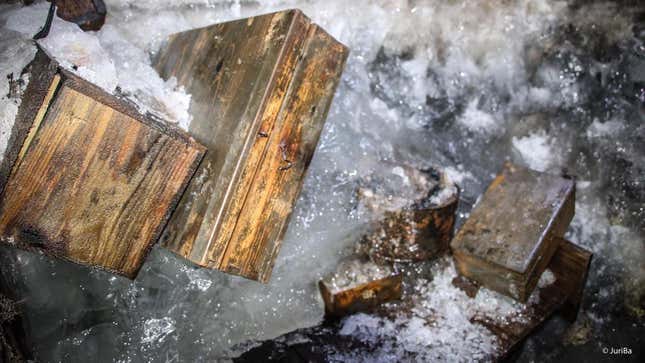
At a park in the Italian Alps, researchers have unearthed a trove of World War I relics that was previously hidden beneath layers of ice and frost. The fascinating discovery is also a sign of a scary climate future.
The team came upon the findings in a cave just below the peak of Mount Scorluzzo in Adamello, Italy. During the war, the cave was a shelter for Austrian soldiers. It’s now part of the outdoor White War Museum in Stelvio National Park. Researchers have long known the shelter existed, yet they were only able to get into it in 2017 when the surrounding glacier melted enough to clear a path. Since then, more ice has melted and researchers have also chipped 78 cubic yards (60 cubic meters) of ice out of the cave. Last month, the museum’s team was able to pull out 300 artifacts, including coins, helmets, weapons, and even corpses.
“It was very exciting,” Stefano Morosini, historian and coordinator of heritage projects at Stelvio National Park, wrote in an email. “No one had been there since 3rd, November 1918. [It was] a sort of time machine.”
The researchers were aided in their quest to excavate the cave by the climate crisis. Rising temperatures have taken their toll on snow and ice across Europe. The find is part of a growing trove of artifacts appearing on the receding edges of glaciers and ice patches across the continent (and other formerly frozen parts of the world for that matter), including some dating back thousands of years.
“The entrance of the cave shelter was hidden and closed by ice,” said Morosini. “When the ice started melting it was possible to slither on the upper part of the barrack” and jump down into it.

The artifacts show that the soldiers had a “poor daily life,” said Morosini. During the war, they were forced to endure below-freezing temperatures. Hypothermia took many of their lives as did getting swept away by avalanches and falling on the treacherous ice and rocks in the Alps.
The soldiers also didn’t seem to have many supplies with them, so they were forced to be thrifty. In the image below, for instance, the object on the far left is a ladle made out of an old can, according to Morosini.



Today, conditions in the Italian Alps are still cold, but less so than they were 100 years ago. Thanks to climate change, the European Alps have heated up by 3.6 degrees Fahrenheit (2 degrees Celsius) above pre-industrial temperatures, which is faster than the global average. Mountains tend to heat up faster because when snow melts, it shows the dark-colored rocks underneath it, which absorb more sunlight and warmth.
This warming is causing ice to melt, permafrost to thaw, and lessening the snowfall that covers the mountains back up. Between 1960 and 2017, the Alps snow season shortened by 38 days. The region has also seen at least 15% of its glaciers retreat since the year 2000, and research shows at least half of the Alps’ glaciers could disappear this century.

The cave site isn’t the only piece of World War I history to melt out of Stelvio National Park’s ice. Over the years, for instance, dozens of corpses have been recovered from the region, sometimes by unexpecting parties. A hiker found a soldier’s remains on the Adamello glacier last summer. Spooky.

The researchers would likely have never come upon these artifacts if it weren’t for all of these climate impacts in the region. “The findings in the cave on Mount Scorluzzo give us, after more than 100 years, a slice of life at over 3,000 meters (9,843 feet) above sea level,” the White War Museum said in a statement.
It’s incredible that the climate crisis is revealing all of this history to us. But much of what we’re seeing in the warming world, like more health issues, more sea level rise, and more inequality—including in Italy—is a lot less cool than these new World War I findings.